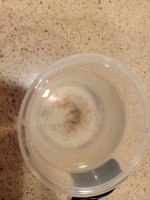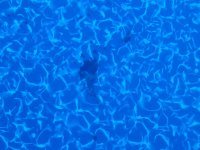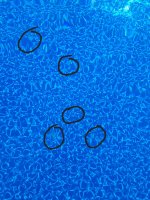We just installed this pool this summer, previously we had a 10k gallon round pool. It had been open just a couple of weeks when problems started. 5 weeks ago it rained for a couple of days and the weather was very warm, the top of the water was beginning to feel slimy but not terrible so I shocked my pool. The next morning the entire bottom was covered in white and brown sand. I've never seen anything like it. I assumed it was dead algae, vacuumed it up.
The next day more stuff appeared on the bottom of my pool, I'd vacuum or brush it and it just kept coming back in the same spots. Shocked it again but didn't seem to do anything, except turn more white or grey dust.
As days went on I went to the pool store and they told me it sounds like mustard algae. We treated for mustard algae with Cal-hypo, triple shocked one day, then quadruple shocked the next, but it just kept coming. Brushed several times a day, vacuum to waste, we then used yellow out and still had more of this dust.
Over the weeks the color changed from grey/white to yellow, then to brown. We took a sample out and looked under a microscope and it looked like sand, at least the brown stuff did. During this time we switched from cal-hypo to liquid shock because it was cheaper and easier to use.
I treated with a metal and scale remover to see if that was it and it didn't seem to do much. Eventually the problem seemed to get better. Except I can't keep my Ph and alkalinity stable.
We added a second return line to improve circulation. We then treated for phosphates because that number skyrocketed after use of the metal and scale remover, phosphates are still high.
Our water was perfectly clear this week, we concluded after microscoping samples it was likely dirt the last couple of weeks from construction in the area.
We did an OCLT and we lost 0 chlorine overnight last weekend. I shocked using liquid shock on Sunday and had no issues in the pool, got up to 18 ppm, no sediment. I used cal-hypo granular last night and ended up with the grey/white sediment in the bottom of the pool again. We looked under the microscope, it looked like sand again, this time in the water there was a white powder.
Is my entire problem due to the cal-hypo shock? Is this a common problem for it to do this if circulation in your pool isn't perfect? I do dissolve in warm water before putting in the pool but obviously it doesn't dissolve 100%.
Is the liquid shock not strong enough to kill algae if algae is my problem?
Secondly, what will cause Ph to constantly increase? My thought is we have aeration happening somewhere in our lines.
This entire time my pool has been balanced perfectly and water has been crystal clear.
Most Recent Chemistry:
FC:5.5
CC:0, stayed at 0 all week even with automatic chlorinator off
CYA:43
Alk:109
Cal:200
Ph:7.6
Phos:5700
Iron:0
Copper:0.1



The next day more stuff appeared on the bottom of my pool, I'd vacuum or brush it and it just kept coming back in the same spots. Shocked it again but didn't seem to do anything, except turn more white or grey dust.
As days went on I went to the pool store and they told me it sounds like mustard algae. We treated for mustard algae with Cal-hypo, triple shocked one day, then quadruple shocked the next, but it just kept coming. Brushed several times a day, vacuum to waste, we then used yellow out and still had more of this dust.
Over the weeks the color changed from grey/white to yellow, then to brown. We took a sample out and looked under a microscope and it looked like sand, at least the brown stuff did. During this time we switched from cal-hypo to liquid shock because it was cheaper and easier to use.
I treated with a metal and scale remover to see if that was it and it didn't seem to do much. Eventually the problem seemed to get better. Except I can't keep my Ph and alkalinity stable.
We added a second return line to improve circulation. We then treated for phosphates because that number skyrocketed after use of the metal and scale remover, phosphates are still high.
Our water was perfectly clear this week, we concluded after microscoping samples it was likely dirt the last couple of weeks from construction in the area.
We did an OCLT and we lost 0 chlorine overnight last weekend. I shocked using liquid shock on Sunday and had no issues in the pool, got up to 18 ppm, no sediment. I used cal-hypo granular last night and ended up with the grey/white sediment in the bottom of the pool again. We looked under the microscope, it looked like sand again, this time in the water there was a white powder.
Is my entire problem due to the cal-hypo shock? Is this a common problem for it to do this if circulation in your pool isn't perfect? I do dissolve in warm water before putting in the pool but obviously it doesn't dissolve 100%.
Is the liquid shock not strong enough to kill algae if algae is my problem?
Secondly, what will cause Ph to constantly increase? My thought is we have aeration happening somewhere in our lines.
This entire time my pool has been balanced perfectly and water has been crystal clear.
Most Recent Chemistry:
FC:5.5
CC:0, stayed at 0 all week even with automatic chlorinator off
CYA:43
Alk:109
Cal:200
Ph:7.6
Phos:5700
Iron:0
Copper:0.1





 You might be seeing some residual product form the cal-hypo settling. Liquid chlorine is our preferred method to chlorinate for non-salt pools and is plenty strong enough if the batch is somewhat fresh. Remember your pH will show higher whenever the FC is over 10.
You might be seeing some residual product form the cal-hypo settling. Liquid chlorine is our preferred method to chlorinate for non-salt pools and is plenty strong enough if the batch is somewhat fresh. Remember your pH will show higher whenever the FC is over 10.